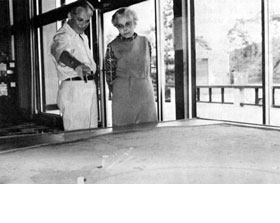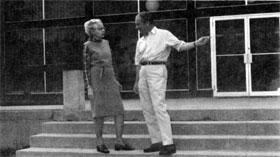Fermi Tradition Lives on at NAL
The addition of the name of Fermi to the title of the National Accelerator Laboratory, at the dedication ceremony to be held at the Laboratory on May 11, brings to the Laboratory a legacy of great, pioneering discovery in nuclear physics by a man whose warmth and patience are treasured by those who knew him.
Many people associated with the National Accelerator Laboratory once worked with Enrico Fermi. They speak of the new insights he brought to nuclear theories and experiments, but they speak of Fermi the man - a teacher with a clear, kindly regard for the level of understanding needed by his students. In the fifteen years he resided in the U.S., Fermi made enormous intellectual contributions to American culture in his work at Columbia University, at the University of Chicago, in the Los Alamos project. The importance of his contributions to nuclear advances in the U.S. and to neutrino research continue to be noted.
Mrs. Laura Fermi, writing of her life with the great scientist in her book, "Atoms in the Family," gives a delightful narrative of the family's move to the United States in 1939. It is a story not only of their personal adjustment to a new land, but a moving account of the pressures of the time which necessitated their decision to leave Italy for the U.S. where Fermi's work could continue.
Some of NAL's people were Fermi's colleagues, some were his undergraduate or graduate students, others worked with him in technical capacities. This is how they remember Enrico Fermi:
Professor Herbert L. Anderson of the University of Chicago, then working on Muon 98 at NAL, met Fermi at Columbia University shortly after Fermi arrived in the U.S. Their association continued until Fermi's death in 1954. Anderson tells of Niels Bohr's visit to Columbia in early 1939 to talk to Fermi about the discovery of fission, the splitting of the atomic nucleus. Fermi was greatly taken with Bohr's news and when he left, that very day Fermi and Anderson set up simple expert-mental equipment that demonstrated the process. They joined a group at Princeton two years later for more advanced experiments on this chain reaction. Such a collaboration between universities, a common practice at NAL in 1974, was a novel idea in 1941, according to Anderson. One of the collaborators was Robert R. Wilson, then an assistant professor at Princeton.
Anderson recalled that Fermi, the theorist, shifted easily to Fermi the experimentalist. "He delighted in producing with his own hands some piece of apparatus that was needed in the experiment. When the cyclotron at Chicago was ready to run, Fermi made a target that could be manipulated from the outside. We called it the 'Fermi trolley.' It used the field in the magnet to move it about. He loved to be given a problem and took pride in coming up with speedy solutions...Fermi liked to do his homework. He worked out the theory of pion production so that we would know what to expect when we began to operate the cyclotron.
"If he could have seen with what excitement and anticipation such great discoveries are being sought these days at NAL, Fermi would have been thrilled. I wish he could have been here."
Robert Bacher, president of the Universities Research Association, met Fermi in 1933 and 1936 at summer lectures for which Fermi travelled to the U.S. from Italy. (Bacher was chairman of the May 11, 1974 dedication program.) In addition to his great intellectual strength, Fermi had enormous physical strength, Mr. Bacher recalled. "I remember catching up with him as he started to swim across a lake at Ann Arbor, to tell him that it was l.5 miles across that lake, but Fermi kept on swimming and went the whole distance. He was a great competitor and loved to win."
Robert R. Wilson, Director of NAL, began his association with Fermi in 1941 in that collaboration at Princeton. Dr. Wilson spoke of the clarity of the Fermi lectures he heard during the ensuing years. "They were always informative, instructive, simple and clear enough for everyone to understand...Fermi was a friend, a colleague, a teacher, and an inspiration."
T.D. Lee, Nobel laureate and Enrico Fermi Professor at Columbia University, was a member of NAL's Program Advisory Committee for several years. Dr. Lee earned his doctorate at the University of Chicago under Fermi. Dr. Lee sees a continuation of Fermi's work at the National Accelerator Laboratory. "He was devoted to the exploration of Nature. Fermi was at the foremost frontier of neutrino experiments, and it is therefore befitting that the Laboratory be named after him."
The cyclotron which began to operate at the University of Chicago in 1951 was then the world's largest. Fermi guided construction of the great technical feat. Important studies in the field of resonances emerged in the strong intellectual climate at Chicago.
Asa Newman, on the staff of the NAL 15 Ft. Bubble Chamber, was an operator of the cyclotron with Mr. Fermi. "I was always amazed at his ability to talk to everyone. He would explain a problem to me in the way I needed it, then to a student on his level, and then to another physicist. He was able to communicate with all of us and would never walk away until we understood it."
Developments in neutrino theory at NAL in the 1970s, which opened the possibility of a link with the patterns of electricity, set the keynote here for the penetrating insights in research to be carried on under Fermi's name at the world's largest atomic research facility.






